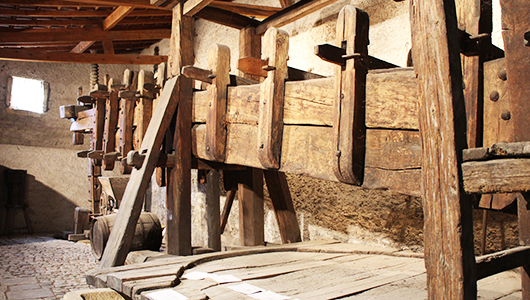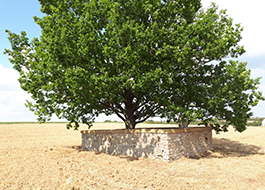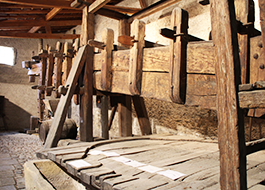Nouilly
Durée visite : 40 minutes
Moyen : Pédestre
Nouilly faisait partie de l’ancien pays messin du Haut-Chemin. Il dépendait des Trois-Évêchés ainsi que du bailliage de Metz. Le village était partagé en trois bans-fiefs qui étaient sièges d’une justice haute, moyenne et basse. Ils étaient en possession du grand chantre de la cathédrale jusqu’à la Révolution ou des grandes familles messines. Les habitants étaient surnommés les péteurs de noyaux. En 1870, la bataille de Borny-Colombey, qui mit hors de combat plus de 8 500 hommes en quelques heures, dont près de 5 000 Allemands, se déroula notamment à Nouilly. Le 26 août 1870 eut lieu le combat de Lauvallières, ou fut engagé le 51e régiment d’infanterie. Le 22 septembre 1870 eut lieu l’affaire de Nouilly, ou fut engagé le 7e bataillon de chasseurs à pied.
Nouilly was part of the old Metz region of Haut-Chemin. It depended on the Trois-Évêchés as well as the bailiwick of Metz. The village was divided into three bans-fiefs which were seats of a high, medium and low justice. They were in the possession of the great cantor of the cathedral until the Revolution or of the great families of Metz. The inhabitants were nicknamed the stalkers. In 1870, the Battle of Borny-Colombey, which knocked out more than 8,500 men in a few hours, including nearly 5,000 Germans, took place in Nouilly in particular. On August 26, 1870 took place the battle of Lauvallières, where the 51st infantry regiment was engaged. On September 22, 1870, the Nouilly affair took place, where the 7th battalion of chasseurs à pied was engaged.
Nouilly war Teil der alten Metz-Region von Haut-Chemin. Es hing von den Trois-Évêchés sowie der Vogtei von Metz ab. Das Dorf war in drei Lehen unterteilt, die Sitze einer hohen, mittleren und niedrigen Gerechtigkeit waren. Sie befanden sich bis zur Revolution im Besitz des großen Kantors der Kathedrale oder der großen Familien von Metz. Die Einwohner wurden die Stalker genannt. 1870 fand insbesondere in Nouilly die Schlacht von Borny-Colombey statt, in der in wenigen Stunden mehr als 8.500 Männer, darunter fast 5.000 Deutsche, außer Gefecht gesetzt wurden. Am 26. August 1870 fand die Schlacht von Lauvallières statt, in der das 51. Infanterieregiment eingesetzt wurde. Am 22. September 1870 fand die Nouilly-Affäre statt, in der das 7. Bataillon der Chasseurs à pied eingesetzt wurde.

Parti de gueules au dextrochère de carnation, vêtu d’azur, mouvant d’une nuée d’argent, tenant une épée du même, garnie d’or, accostée de deux cailloux du même ; et mi-parti de gueules à l’aigle contournée d’or.
A dextre ce sont les armes du chapitre de la cathédrale de Metz, qui possédait le » ban Saint Paul « . A senestre ce sont les armes de la famille Piedeschaux à laquelle appartenait le » ban le Sénéchal « .
Party Gules with dextrochère of carnation, dressed in azure, moving with a cloud of silver, holding a sword of the same, garnished with gold, accosted by two pebbles of the same; and half-party Gules with an eagle circled with gold.
On the right hand side are the arms of the chapter of Metz cathedral, which had the « ban Saint Paul ». On the left are the arms of the Piedeschaux family to which the « Ban le Sénéchal » belonged.
Party Gules mit Dextrochère der Nelke, in Azurblau gekleidet, mit einer silbernen Wolke bewegend, ein Schwert desselben haltend, mit Gold garniert, mit zwei Kieselsteinen desselben angesprochen; und Halbpartei Gules mit einem eingekreisten Adler.
Auf der rechten Seite befinden sich die Arme des Kapitels des Metz-Doms, in dem das « Ban Saint Paul » stand. Links die Wappen der Familie Piedeschaux, zu der das « Ban le Sénéchal » gehörte.

Les habitants et les habitantes de Nouilly s’appellent les Novillois et les Novilloises.
The inhabitants of Nouilly are called the Novillois and the Novilloises.
Die Einwohner von Nouilly heißen Novillois und Novilloises.
Les points de visites
.
Ce n’est pas une gare monumentale. Après 1870, la longueur du réseau d’Alsace-Lorraine a presque triplé. De 862 km de lignes en 1871, le réseau compte 1 803 km de lignes à voie normale, et 80 km de lignes à voie étroite à la veille de 1914. Pendant l’annexion, les trains roulent du côté droit sur les lignes à double voie en Alsace et en Moselle, alors qu’ailleurs en France, ils roulent du côté gauche. Le réseau disposait d’une signalisation ferroviaire qui lui était spécifique. Adoptée par les allemands en 1907, puis reprise par les français, celle-ci perdurera jusqu’en 1938.
It is not a monumental station. After 1870, the length of the Alsace-Lorraine network almost tripled. From 862 km of lines in 1871, the network had 1,803 km of normal gauge lines, and 80 km of narrow gauge lines on the eve of 1914 . During annexation, trains run on the right side on double-track lines in Alsace and Moselle, while elsewhere in France, they run on the left side. The network had specific railway signaling. Adopted by the Germans in 1907, then taken over by the French, it will last until 1938.
Es ist keine monumentale Station. Nach 1870 hat sich die Länge des elsässisch-lothringischen Netzes fast verdreifacht. Von 862 km Strecken im Jahr 1871 verfügte das Netz über 1.803 km Normalspurstrecken und 80 km Schmalspurstrecken am Vorabend des Jahres 1914. Während der Annexion fahren die Züge auf der rechten Seite auf zweigleisigen Strecken im Elsass und an der Mosel, während sie anderswo in Frankreich auf der linken Seite fahren. Das Netz hatte spezifische Eisenbahnsignale. 1907 von den Deutschen adoptiert und dann von den Franzosen übernommen, wird es bis 1938 dauern.
.
.
Le carré militaire était au milieu d’un champ, mais bientôt il sera au milieu des lotissements. C’est une tombe individuelle d’un officier et de deux stèles, avec chacune dix noms de militaires, issus de la 10eme compagnie du 2eme Ostpreussisches Grenadier Regiment Nr 3, tués lors de la bataille de Borny-Colombey le 14 août 1870.
The military square was in the middle of a field, but soon in the middle of housing estates. It is an individual grave of an officer and two stelae, each with ten names of soldiers, from the 10th company of the 2nd Ostpreussisches Grenadier Regiment Nr 3, killed during the Battle of Borny-Colombey on August 14, 1870.
Der Militärplatz befand sich mitten auf einem Feld, aber bald mitten in Wohnsiedlungen. Es ist ein Einzelgrab eines Offiziers und zweier Stelen mit jeweils zehn Namen von Soldaten aus der 10. Kompanie des 2. Ostpreussischen Grenadier-Regiments Nr. 3, die während der Schlacht von Borny-Colombey am 14. August 1870 getötet wurden.
.
Témoin du passé vigneron du village, classé monument historique, cet imposant pressoir à bascule, construit au XVIe, rappelle que dans ce village s’étendait naguère le plus grand vignoble du Pays Messin.
Witness of the village’s winegrowing past, listed as a historic monument, this imposing rocking press, built in the 16th century, reminds us that in this village the largest vineyard in the Messin region was once extended.
Diese imposante Schaukelpresse aus dem 16. Jahrhundert zeugt von der Vergangenheit des Winzers im Dorf, das als historisches Denkmal eingestuft wurde. Sie erinnert uns daran, dass in diesem Dorf einst der größte Weinberg der Region Messin erweitert wurde.








